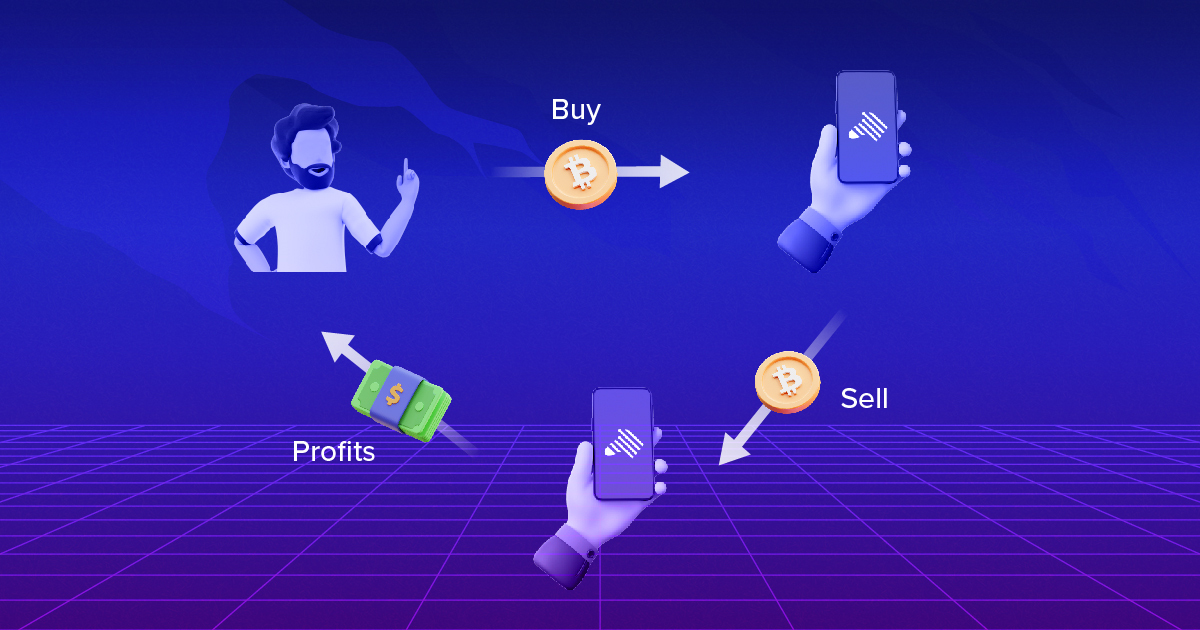Introduction
In the rapidly evolving world of crypto trading, investors and traders perpetually explore methods to optimise gains while mitigating risks. One increasingly favoured approach is crypto arbitrage trading, which capitalises on slight price variations in a crypto asset. This blog explains the concept of crypto arbitrage trading, its mechanisms, variations, advantages, and associated risks.
What is Arbitrage Trading?
Crypto arbitrage trading involves capitalising on price differentials in a crypto trading pair across various markets or platforms. Arbitrage traders seek to exploit these variances by purchasing the crypto at a lower price on one platform and selling it simultaneously at a higher price on another platform.
While this strategy initially emerged with traditional assets, it has gained traction in the global crypto markets due to the widespread trading of crypto across numerous exchanges and countries. This extensive market presence renders crypto highly conducive to arbitrage, enabling traders to leverage price inconsistencies across these exchanges for potential profit.
Read more: Crypto Investing vs Crypto Trading
How Does Arbitrage Work?
Below are the steps outlining how arbitrage trading operates.
- Identifying Price Discrepancies: Arbitrage traders in the crypto space continuously monitor various cryptocurrency exchanges in real time. They search for instances where the same digital asset is traded at varying prices across different platforms.
- Purchase at a Lower Price: Once a price difference is detected, traders swiftly buy the cryptocurrency on the exchange where it is priced lower. This transaction usually occurs immediately to exploit the price gap before it diminishes.
- Selling at a Higher Price: Following the purchase, traders transfer the asset to another exchange where prices are higher. They then sell it at an elevated rate, thereby profiting from the price differential.
Read more: Crypto Technical Analysis For Beginners
An Example of Crypto Arbitrage Trading:
- Ethereum (ETH) on Exchange A: The present price of Ethereum on Exchange A stands at $25,000.
- Ethereum (ETH) on Exchange B: Concurrently, Ethereum is being traded at $25,600 on Exchange B.
- The Arbitrage Opportunity: A crypto arbitrage trader identifies this price difference and promptly acquires one Ethereum on Exchange A for $25,000.
- Arbitrage Execution: The trader expeditiously transfers the Ethereum to Exchange B and sells it for $25,600.
- Profit Calculation: Through executing this arbitrage transaction, the trader realises a profit of $600 (after deduction of transaction fees).
Types of Arbitrage Trading
Various strategies are employed in crypto arbitrage trading, with some of the most prevalent ones detailed below.
Cross-platform arbitrage: This approach entails purchasing and selling the same crypto simultaneously across different exchanges. It may involve transferring assets between platforms to leverage price differentials effectively.
Intra-platform arbitrage: This method involves capitalising on price variations between trading pairs within the same exchange. Traders identify correlated pairs and execute transactions to exploit discrepancies in pricing.
Triangular arbitrage: This technique exploits price differences among three distinct cryptos traded in a triangular configuration. For instance, if there is an arbitrage opportunity between BTC, ETH, and SOL, a trader might engage in a series of trades to profit from disparities in their exchange rates.
Read more: Crypto Trading Strategies: A Complete Guide
Benefits of Arbitrage
Now, let’s explore several advantages of arbitrage trading.
Profit: Engaging in arbitrage provides an avenue for regular profits by leveraging price differentials.
Diversification of Risk: Arbitrage enables the spreading of investment risk by participating in multiple trades concurrently.
Ease of Access: Crypto arbitrage is open to traders at all skill levels, from novices to seasoned experts.
More Market Efficiency: The alignment of prices across diverse exchanges contributes to bolstering market efficiency.
How Do You Spot Arbitrage Trading Opportunities?
Discovering arbitrage opportunities presents an effective approach to generating profits in crypto trading. However, crypto arbitrage is a complex strategy demanding expertise, perseverance, and swift decision-making abilities.
To pinpoint suitable arbitrage chances, you must scrutinise crypto prices across different exchanges. Employing crypto arbitrage software and tools aids in monitoring prices across multiple exchanges, facilitating the identification of price differentials conducive to profit generation.
Vigilance regarding market trends and crypto volatility is vital when seeking arbitrage opportunities. Given the extreme volatility of crypto markets and rapid price fluctuations, prompt action and decision-making based on prevailing market conditions are imperative.
Read more: How to Start Investing in Crypto with ZebPay
Arbitrage Trading: Risks and Challenges
Similar to any trading approach, arbitrage trading carries inherent risks. Potential losses can arise from slippage, trading fees, and unexpected fluctuations in crypto prices. Key risks to consider encompass:
Price slippage: This represents a critical factor in arbitrage trading, particularly in swiftly moving markets characterised by high volatility. Slippage occurs when there are disparities between the actual execution price and the anticipated price due to rapid price fluctuations between trade initiation and execution. Significant price movements during this interval can diminish expected profits or even lead to losses.
Fees: Trading fees, withdrawal charges, and other associated expenses can impact the profitability of arbitrage trades.
Trade Speed: Effective arbitrage trading hinges on prompt trade execution to capitalise on price differentials. Delays in execution, whether stemming from technical issues, sluggish internet connectivity, or exchange-related factors, can result in financial losses.
Read more: Day Trading vs Hodling
Conclusion
As financial markets progress, arbitrage trading is expected to transform. Technological advancements and regulatory shifts are anticipated to influence the tactics employed by arbitrageurs. Furthermore, the incorporation of blockchain technology and decentralised finance (DeFi) platforms may introduce fresh prospects for arbitrage opportunities.
Arbitrage trading holds the potential for profitability if you have a comprehensive understanding of its mechanics and the utilisation of tools for efficient execution. However, it is essential to conduct thorough research and invest only capital that one can afford to lose.
You can read more about Web 3.0, Crypto and blockchain on ZebPay blogs. Join the millions already using ZebPay.






